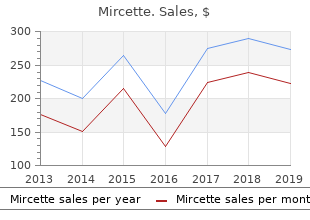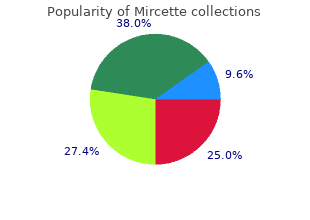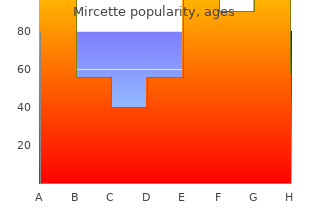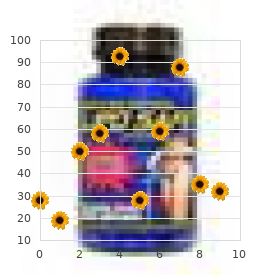Mircette
"Generic mircette 15mcg, birth control and weight loss".
By: H. Bandaro, M.S., Ph.D.
Vice Chair, Louisiana State University
Treated by �extensive� excision with primary closure birth control 777 quality 15 mcg mircette, split-thickness pores and skin graft birth control for pcos proven mircette 15mcg, or (i) Grows vertically birth control expiration mircette 15 mcg, typically with early floor ulceration flap closure birth control pills delay period proven mircette 15 mcg. Please notice that permanent sections are often required to (d) Acral lentiginous melanoma (5%) decide clear margins, and that frozen sections is probably not reliable for this (i) On mucous membranes, palms, soles and subungual function. Histologic staging and correlation with metastases (b) Thick lesions (greater than 1 mm) = 2 cm margin i. Breslow�s depth of invasion � more reliable indicator of prognosis than (c) Note that margin additionally is determined by location and could also be compromised in Clark�s stage (. High recurrence rate in cases where extensive local excision scars and keloids: A evaluation. Unilateral (a) Complete Problems of the pinnacle and neck in the practice of plastic surgery embody congenital, traumatic, (b) Incomplete infectious, neoplastic, and other conditions. Bilateral of the pinnacle and neck is essential in the diagnosis and surgical therapy of those ailments. Cleft Lip: occurs anterior to the incisive foramen and can also contain the alveolar course of b. Primary cleft palate: failure of fusion of median and lateral palatine processes ii. Cleft lip with palate types at four-6 weeks as a result of lack of mesenchymal penetration (merging) and fusion b. Malocclusion because of intrinsic deformities of alveolar course of and teeth iii. Lack of continuity of pores and skin, muscle and mucous membrane of lip with related nasal deformity and nasal obstruction iv. Inability to separate nasal from oral cavity so that air and sound escape carried out earlier, however both affected person and parents must be suggested that the via nose in tried speech growing child could �outgrow� the correction, necessitating a repeat process. Repair of pores and skin, muscle and mucous membrane to restore complete continuity chamber of lip, symmetrical size and performance iv. In extensive clefts (>10mm), presurgical orthodontics (palatal equipment, glossoptosis). In these cases, airway obstruction and failure to thrive could also be nasoalveolar molding) could also be indicated, or a cleft lip adhesion (surgical procedure to present. At the time of eruption of permanent canine teeth Because of a number of problems with speech, dentition, listening to, and so forth. Secondary Repair of the affected person with a cleft must be by an interdisciplinary group, ideally in a a. Orthognathic Lefort I osteotomy for maxillary hypoplasia (sixteen years) orthodontist, dentist, geneticist, pediatrician, speech therapist, audiologist, social ii. Range of cleft lip repair varies from 0-three months of age in full-time period, in any other case a. Order of frequency according to suture sort: months of age, if potential (a) Sagittal c. Most facilities perform secondary bone grafting on the stage of combined dentition (a) Sagittal scaphocephaly (scapho, Gr. In 25% of cleft patients, orthognathic surgical procedure (jaw-straightening process) incidence of developmental delay has to be carried out to appropriate a malocclusion (irregular chew). Orthognathic surgical procedure can only be carried out in skeletally mature people (a) anterior vault reshaping (fronto-orbital development/reshaping) (14-sixteen years of age, ladies; 17-19 years of age, men). Third-most common congenital malformation (following club foot and cleft (a) Apert (craniosynostosis, exorbitism, midfacial retrusion with complicated lip and palate). No genetic defect ascribed; leading theory of trigger is expounded to stapedial (c) Pfeiffer (craniosynostosis, exorbitism, midfacial retrusion, broad thumbs artery thrombosis during embryogenesis and toes) (a) 1st & 2nd branchial arches affected ii. Manifestations: Pfeiffer syndrome patients usually develop usually (a) hemifacial deficiency (skeletal and delicate tissue) iv. Goals of surgical procedure: (b) microtia (a) Release fused cranial sutures (c) mandibular hypoplasia (b) appropriate profound exorbitism to prevent corneal publicity/blindness (i) malocclusion from an irregular cant (secondary to reduced vertical (c) appropriate malocclusions peak of the ramus) vi. Surgical interventions: (d) macrostomia (a) Anterior/posterior/complete vault reshaping (0-1 years) (e) listening to loss (b) Monobloc (osteotomy and advance brow and face concurrently with vi. Associated with Tessier #7 facial cleft and variable facial nerve palsy bone grafts/fixation) vii. Clinical manifestations: (i) Skeletal: autogenous bone (calvarium, rib, iliac crest) (a) hypoplasia/aplasia of the zygomatic bone (ii) Soft tissue: free flap and/or fats grafting (i) lateral orbit deficiency (b) Mandibular depends upon severity of hypoplasia. Distraction could also be (ii) midface retrusion essential for reaching correction of malocclusion versus standard (iii)lateral canthus hypoplasia/downward slanting palpebral fissures orthognathic procedures to appropriate jaw discrepancies in adolescence. Manifestations: (ii) necessitates tracheostomy and distraction of mandible (a) hemifacial microsomia, (e) choanal atresia (b) vertebral backbone abnormalities (f) bilateral cleft palate (c) abnormalities of heart, kidneys, lungs (g) normal intelligence three. Consider affected person historical past oropharynx, or as a fistula between both pores and skin and oropharynx openings b. Physical examination for asymmetry, bone mobility, diplopia, extraocular muscle iii. Absence of half or all of exterior ear with mandibular deformity (hemifacial microsomia) iv. Treatment: (a) Anotia or microtia-development from autogenous cartilage graft or synthetic implant, vascularized fascial flap, pores and skin graft � usually requires multiple operation. Control of lively bleeding by pressure until management by directly ligating in working iv. Panorex x-ray if mandible fracture present and C-backbone cleared room or embolization in interventional radiology suite 2. Palpate facial skeleton for underlying bone harm; rule out harm to facial nerve, a. Use of affected person�s dentures or fabricated short-term dentures in edentulous affected person 7. When dealing with panfacial fracture, stabilize articulating component (mandible), b. Careful wound irrigation with physiologic solution �inside-out� (Manson), establishing facial peak, width, and projection by. Meticulous re-approximation of anatomy aligning key facial buttresses (open reduction) and plating of fractures (internal fixation) 36 37 three. Mandible � typically bilateral (ring idea) (b) Ophthalmology session if suspicious of globe harm i. Indications for surgical procedure (c) C-backbone x-ray: 10-thirteen% of mandible fractures coincide with c-backbone (a) Entrapment fracture; keep C-backbone stabilization until absence of harm can be (b) Enophthalmos confirmed (i) Severe displacement creating facial asymmetry b. Pediatric craniofacial fractures: Usually more conservative with operative repair i. Surgical removal of whole gland with sparing of nerve branches that are on this affected person inhabitants, as a result of growing facial skeleton and growing clearly not concerned dentition. The head and neck are relatively proof against an infection as a result of their sturdy vascularity excision B. Upper aerodigestive infections could monitor into the mediastinum � (10%) male, age 40-70 2. Scalp and orbital infections could spread intracranially via the dural sinuses and b. Any mass in the pre-auricular area or on the angle of the jaw is a parotid (a) Most are squamous cell carcinoma or variants tumor until proven in any other case (b) Palate carcinomas are often of minor salivary gland origin b. Bimanual palpation � simultaneous intraoral and exterior palpation (c) Sarcomas in mandible, tongue, other websites are rare c. Must additionally look at the vertical peak of the midface (vertical maxillary extra, v. Bone overgrowth (c) Palliative resection could also be indicated for consolation and hygiene iv. Bruxism (d) Immediate reconstruction with vascularized flaps when indicated by dimension v. Micro � and macrogenia � beneath or overdevelopment of chin Loss of facial nerve results in very significant asymmetry b. X-rays, including a cephalogram (lateral x-ray at a hard and fast distance) to measure muscle activity of normal side (if unilateral) relationships of cranium, maxilla and mandible 1. Idiopathic (Bell�s palsy) surgical procedure is carried out on the casts to decide diploma of development/setback b. Vascular (intracranial) needed, with or without orthodontic corrective measures as needed 2.


Histioteuthidae 511 Histioteuthis celetaria celetaria (Voss birth control pills joint pain trusted mircette 15mcg, 1960) Frequent synonyms / misidentifications: None / None birth control for migraine with aura trusted 15mcg mircette. Suckers in median 2 or 3 rows of manus in the tentacular club slightly and roughly coequal enlarged birth control controversy proven mircette 15mcg. Known predators are Prionace glauca (blue shark) and Alepisaurus ferox (longnose lancetfish) birth control 28 day pack effective mircette 15 mcg. Distribution: From Azores and Madeira to 19�S in the east Atlantic; west Atlantic from Nova Scotia to Brazil; current however poorly known in subtropical South Atlantic 512 Cephalopods Histioteuthis co rona co rona (Voss and Voss, 1962) Frequent synonyms / misidentifications: None / None. Light organs on ventral aspect of the mantle in moderately widely spaced sample; terminal group of regular gentle organs on arms absent; circle around right eye composed of 17 (occasionally 16) large gentle organs; 7 or eight large gentle organs in arc over anterior margin of left eye with 3 small gentle organs on dorsal margin and four small ones on ventral margin of eyelid, 2 smaller additional gentle organs normally on extra instant posteroventral margin. Known predators are Aphanopus carbo (black scabbardfish), Kogia breviceps (pygmy sperm whale) and Ziphius cavirostris (Cuvier�s beaked whale). Distribution: In the east Atlantic from 46�N to 27�S; in the west Atlantic from roughly 45�N to Uruguay (36�S); Gulf of Mexico. Histioteuthidae 513 Histioteuthis macrohista Voss, 1969 Frequent synonyms / misidentifications: None / None. Dorsal pad of funnel organ inverted V-formed with robust apical papilla; large semicircular valve current. Suckers on the manus of the tentacles organized in 6 diagonal rows, with those in medial 2 rows enlarged to 2 instances diameter of ventral marginal suckers; rings of suckers with numerous sharp tooth around whole margins. Occurring from floor to 2 500 m; juveniles and subadults in midwater all through whole vertical range at evening; subadults also near the bottom at seven-hundred to 800 m; mature males at a hundred to 600 m at evening. Males mature at 40 to fifty three mm mantle length, females from about 49 to more than sixty five mm. Known predators are Ommastrephes bartramii (neon flying squid), Prionace glauca (blue shark), Genypterus blacodes (ling, pink cusk-eel), Thunnus albacares (yellowfin tuna), Thunnus obesus (bigeye tuna), Arctocephalus gazella (Antarctic fur seal), Physeter catodon (sperm whale), Diomedea exulans (wandering albatross), Phoebetria fusca (sooty albatross) and Puffinus tenuirostris (brief-tailed shearwater). Distribution: Almost circumglobal, primarily in the transitional and fringing waters of the Southern Subtropical Convergence, between about 33� and forty seven�S, extending northward in the eastern Atlantic to 23�S and possibly further north off Namibia. Large females might endure diel vertical migration and spawning could occur in deep water. Known predators are Galeocerdo cuvieri (tiger shark), Thunnus obesus (bigeye tuna), Globicephala macrorhynchus (brief-finned pilot whale), Hyperoodon ampullatus (northern bottlenose whale), Physeter catodon (sperm whale), Ziphius cavirostris (Cuvier�s beaked whale), Phoebetria fusca and P. Distribution: Madeira, Canaries, Mauritania, Guinea Bissau, Gulf of Guinea, Gabon, off Namibia; western Indian Ocean and western and central Pacific. Inner web low to vestigial between dorsal 3 pairs of arms, outer web not conspicuously developed. Tentacular suckers in about 6 diagonal rows, the medial rows enlarged particularly central four or 5 of extra ventral of 2 rows. Eighteen gentle organs, 17 large and 1 small, in closed circlet around right eye; 7 large gentle organs in arc over anterior margin of left eye with 10 to 14 small gentle organs regularly spaced around remaining margin of eyelid. Juveniles at zero to 630 m by day and zero to 260 m at evening; subadults at 80 to 300 m at evening; mature females at 500 to 1 000 m by day; mature males and females in midwater at 800 to 1 000 m by day and ventral view in midwater and near the bottom at 600 to 1 300 m at evening. Females (from Guerra, 1992) mature at 114 to 186 mm mantle length and endure fast elongation of the mantle shortly before reaching maturity; mature females ascend the water column to spawn and die in shallow water. Abundant near slopes and submarine ridges; 46 to 370 km from shore off Namibia; Known predators are Aristaeomorpha foliacea (large purple shrimp), Etmopterus spinax (velvet belly), Galeus melastomus (blackmouth catshark), Prionace glauca (blue shark), Xiphias gladius (swordfish), Globicephala melas (long-finned pilot whale), Grampus griseus (Risso�s dolphin), Hyperoodon ampullatus (northern bottlenosed whale), Kogia breviceps (pygmy sperm whale), Stenella coeruleoalba (striped dolphin) and Ziphius cavirostris (Cuvier�s beaked whale). Widely distributed in the temperate eastern Atlantic from 60�N to roughly 23�S; ample in Mauritanian upwelling region, ranging southward to Namibia and South African west coast, and east to 35�S 23�E and forty four�S 26�E; northwestern Atlantic from subarctic (�fifty two�N) to Suriname. Apparently absent from the Gulf of Mexico, Caribbean Sea and South Atlantic Central water mass. Joubiniteuthis portieri (Joubin, 1916) Frequent synonyms / misidentifications: Valdemaria danae Joubin, 1931 / None. Tentacles a lot thinner than arms; tentacular club laterally compressed; bears suckers in 5 to 12 series. However, the fins are very large and all arms are extremely long and the tentacles are practically indistinguishable from the arms, making the magnapinnid squids seem to have ventral view dorsal view 10 identical arms. Little is known about the biology of this species, which is represented by few specimens. The squid household Magnapinnidae (Mollusca: Cephalopoda) in the Atlantic Ocean, with a description of a brand new species. A Monograph of the Cephalopoda of the North Atlantic: the household Joubiniteuthidae. Arm suckers in 2 rows, some of them enlarged in males, that are geared up with a pair of grossly enlarged sabre-like hooks. Size: Maximum mantle length 1 000 mm, weight �eleven kg, estimated from beaks; maximum recorded female mantle length 970 mm; male mantle length 422 mm; at maturity females attain twice the dimensions of males. Collected in depths of zero to 1 a hundred m; paralarvae and juveniles at zero to seven-hundred m at evening, zero to 585 m by day. Until very lately, adults were known solely from stomachs of predators, mainly the sperm whales; also known from stomachs of Grampus griseus (Risso�s dolphin), Aphanopus carbo (black scabbardfish), a tuna (Tunnus obesus), Alepisaurus ferox (longnose lancetfish) and Diomedea exulans (wandering albatross). Distribution: Madeira, Canary Islands; northwestern Atlantic from Bermuda and Nova Scotia, northeastern Atlantic from Ireland to Spain and the Azores; western, central and eastern South Atlantic; South Georgia; southern Indian Ocean, western, central and eastern Pacific, south Tasmania. Journal of the Marine Biological Association of the United Kingdom, 83: 1099�1100. Systematic status of Lepidoteuthis, Pholidoteuthis and Tetronychoteuthis (Cephalopoda: Oegopsida). Occupying mesopelagic depths through the day and migrating into near-floor waters at evening. Strong sexual photophores dimorphism generally morphology happens in some species. Remarks: Two subfamilies are recognized, the anal photophores Lycoteuthinae and the Lampadioteuthinae. Enoploteuthidae: have hooks on arms; have gentle organs on ventral surfaces of head and mantle. Onychoteuthidae Enoploteuthidae Key to the species of Lycoteuthidae occurring in the space 1a. Spherical tail gentle organ current at finish of mantle, projecting past fins List of species occurring in the space the image % is given when species accounts are included. A new species of Nematolampas (cephalopoda: Oegopsida) from the Western Central Atlantic with an outline of the household Lycoteuthidae. Growth and mating of southern African Lycoteuthis lorigera (Steenstrup, 1875) (Cephalopoda; Lycoteuthidae). The lycoteuthid genus Oregoniateuthis Voss, 1956, a synonym of Lycoteuthis Pfeffer, 1900 (Cephalopoda:Teuthoidea). Cephalopods of the Beguela Current off Namibia: new additions and issues on the genus Lycoteuthis. A note on three specimens of the squid Lampadioteuthis megaleia Berry, 1916 (Cephalapoda: Oegopsida) from the Atlantic ocean, with a description of the male. Lycoteuthidae 523 Lampadioteuthis megaleia Berry, 1916 Frequent synonyms / misidentifications: None / None. Diagnostic characters: Four ocular photophores current: 3 ventral in a line, 1 lateral, all four set far aside. Distribution: Portugal, Morocco to Cape Verde Islands; northwestern Atlantic on the periphery of Sargasso Sea; southwestern Pacific. Tentacular stalk with 2 gentle organs and mantle cavity with eight to 10 luminous organs. Known predators are Holohalaelurus regani (Izak catshark), Merluccius capensis (Cape hake), M. Distribution: Central South Atlantic: off Brazil and Argentina; off Namibia and South African west coast. Remarks: the long-used name for this species, acquainted to most teuthologists even presently, was Lycoteuthis diadema (Chun, 1900). Lycoteuthidae 525 Selenoteuthis scintillans Voss, 1958 Frequent synonyms / misidentifications: None / None. Diagnostic characters: Five gentle organs on ventral aspect of eyeball, organized in 1 row. Tentacular stalk with 3 gentle organs and mantle cavity with eight to 10 luminous organs.

This constitutes the most typical means of producing rotational motion birth control pills instructions safe mircette 15mcg, as in Figure 5 birth control list trusted 15 mcg mircette. The eccentric force right here could be transformed by adding two equal and reverse forces at the centre of mass birth control for women lenceria safe 15 mcg mircette, as in Figure 5 birth control pills in green case safe mircette 15 mcg. This leaves a �pure� force (F) appearing by way of the centre of mass, which causes solely linear motion, F = d(m v)/dt; the torque M causes solely rotation, M = dL/dt. This example could possibly be held to justify the usage of the term �torque� for the turning eect of an eccentric force although, strictly, �torque� is dened because the moment of a force couple. There is a strong case for abandoning the usage of the term moment of a force or couple entirely in favour of torque, given the various different uses of the term moment in biomechanics. Checking of linear motion Checking of linear motion happens when an already shifting physique is suddenly stopped at one level. An example is the foot plant of a javelin thrower within the delivery stride, although the illustration of such a system as a quasi-rigid physique is of restricted use. It is finest considered in that approach to avoid misunderstandings that exist within the literature, corresponding to the misunderstanding that O is the instantaneous centre of rotation. This last sentence begs the query of where the instantaneous centre of rotation does lie in such cases. By Newton�s second regulation of linear motion, the magnitude of the acceleration of the centre of mass of the rigid physique, mass m, is ag = F/m. From Newton�s second regulation of rotation (see above), the magnitude (F c) of the moment of the force F is equal to the product of the moment of inertia of the physique about its centre of mass (Ig) and its angular acceleration. This offers a tangential acceleration ( r) that increases linearly with distance (r) from G. At level R (r = b), the two accelerations are equal and reverse and, due to this fact, cancel to give a zero internet acceleration. The position of R is given by equating F/m (= ag) to F b c/Ig, the tangential acceleration at R. The centre of percussion is necessary in sports by which objects, corresponding to balls, are struck with different objects corresponding to bats and rackets. If the influence happens at the centre of percussion, no force is transmitted to the arms. For an object corresponding to a cricket bat, the centre of percussion will lie a way below the centre of mass, whereas for a golf membership, with the mass concentrated within the membership head, the centres of percussion and mass extra practically coincide. If the grip position is a good distance from the centre of mass and the centre of percussion is close to the centre of mass, then the position of the centre of percussion shall be less sensitive to changes in grip position. This is achieved by shifting the centre of mass in direction of the centre of percus sion, as for golf clubs with mild shafts and heavy membership heads, and cricket bats for which the mass of the bat is constructed up across the centre of percussion. Much tennis racket design has evolved in direction of positioning the centre of percussion nearer to the likely influence spot. The benets of such a design feature embody less fatigue and a discount in injury. The application of the centre of percussion idea to a typically non-rigid physique, such because the human performer, is problematic. If F is directed by way of the centre of percussion, there shall be no resultant acceleration at R (the foot�floor interface). The horizontal part of the influence force will oppose relative motion and trigger an acceleration distribution, as in Figure 5. Transfer of angular momentum the precept of transfer of angular momentum from phase to phase is typically considered to be a basic precept of coordinated motion. This is typically interpreted in phrases solely of the two �quasi-static� end positions � totally kidnapped arms, and arms drawn in to the physique. The former position has a big moment of inertia, and hence low pace of rotation; the latter position has a low moment of inertia and high pace of rotation. However, from the kidnapped-arms to the tucked-arms position, the arms lose angular momentum as they transfer in direction of the physique, �transferring� some of their angular momentum to the remainder of the physique which, due to this fact, turns quicker. Trading of angular momentum the term �trading� of angular momentum is often used to check with the transfer of angular momentum from one axis of rotation to one other. The diver then adducts her left arm, or performs another asymmetrical motion, by a muscular torque that evokes an equal however reverse counter-rotation of the remainder of the physique to produce an angle of tilt. No external torque has been utilized so the angular momentum (L) is still fixed about a horizontal axis however now has a part (Ltwist) concerning the twisting axis. The diver has �traded� some somersaulting angular momentum for twisting, or longitudinal, angular momentum and will now both somersault and twist. It is often argued that this methodology of producing twisting angular momentum is preferable to �contact twist� (twist generated when in contact with an external surface), as it may be extra easily eliminated by re-establishing the original physique position before landing. This can avoid issues in gymnastics, trampolining and diving attributable to landing with residual twisting angular momentum. The crucial consider producing airborne twist is to set up a tilt angle and, roughly, the twist fee is proportional to the angle of tilt. In practice, many sports performers use both the contact and the airborne mechanisms to purchase twist. The mathematical analysis of the dynamics of such actions is beyond the scope of this guide. The three-dimensional dynamics of even a rigid or quasi-rigid physique are removed from simple. For example, in two-dimensional rotation of such our bodies, the angular momentum and angular velocity vectors coincide in path. Nutation additionally happens, for example, when carry out ing an airborne pirouette with asymmetrical arm positions. The physique�s longitudinal axis is displaced away from its authentic position of coincidence with the angular momentum vector, generally referred to as the axis of momentum, and will describe a cone round that vector. Furthermore, the equation of conservation of angular momentum applies to an inertial body of reference, corresponding to one shifting with the centre of mass of the performer however at all times parallel to a xed, stationary body of reference. Most force measurements in sport use a force plate, which measures the contact force parts ure 5. The measured force appearing on the performer has the identical magnitude as, however opposite direction from, the reaction force exerted on the performer by the force plate, by the regulation of motion�reaction. In such analysis, motion data from videography, or one other motion analysis system, are used with force, torque and centre of stress data to calculate the resultant forces and torques at physique joints. The mostly used have a relatively small contact area, for example 600 400 mm for the Kistler type 9281B11 (Kistler Instrument Corporation, Winterthur, Switzerland; Forces of interplay between the sports performer and gadgets of sports gear can also be measured using different force transducers, often function-constructed or adapted for a specific application. Such transducers have been used, for example, to measure the forces exerted by a rower on an oar, or by a bike owner on his or her bike�s pedals. Many of the principles discussed on this chapter for force plates additionally apply to force transducers normally. This data could be obtained from stress plates, pads and insoles, which shall be considered within the next section. Force plates used to consider sporting efficiency are refined electronic gadgets and are typically very correct. They incorporate a force transducer, which converts the force into an electrical signal. The transducers are mounted on the helps of the rigid surface of the force plate, often one assist at every of the 4 corners of a rectangle. The indicators from the transducers are amplied and will undergo different electrical modication. The amplied and modied indicators are converted to digital indicators for laptop pro cessing. The signal is then sampled at discrete time intervals, expressed because the sampling fee or sampling frequency. The Nyquist sampling theorem (see Chapter 4) requires a sampling frequency no less than twice that of the best signal frequency. It should be remembered that, although the frequency content material of a lot human motion is low, many force plate applications involve impacts, which have a higher frequency content material. Accurate (legitimate) and dependable force plate measurements rely upon sufficient system sensitivity, a low force detection threshold, high linearity, low hysteresis, low crosstalk and the elimination of cable interference, electrical inductance and temperature and humidity variations. The plate have to be suciently massive to accommodate the motion under investigation. The plate is often sited on the bottom oor of a constructing in a big concrete block. If mounted outside, a big concrete block sited on pebbles or gravel is often an acceptable base and a spotlight have to be given to issues of drainage.
Effective 15mcg mircette. FALCON1 live @ Polskie Radio CZWÓRKA.



